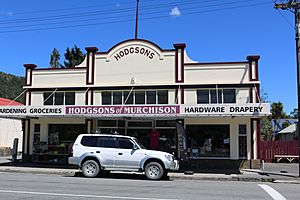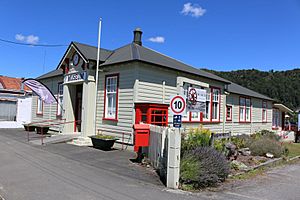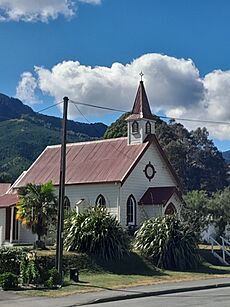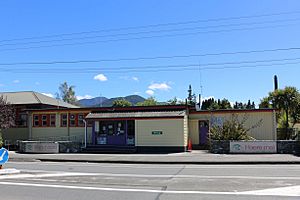Murchison, New Zealand facts for kids
Quick facts for kids
Murchison
|
|
|---|---|
|
Rural settlement
|
|
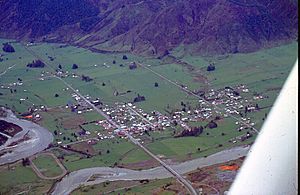
Aerial view of Murchison in 1978
|
|
| Country | New Zealand |
| Territorial authority | Tasman |
| Ward | Lakes-Murchison Ward |
| Electorates |
|
| Area | |
| • Total | 4.34 km2 (1.68 sq mi) |
| Population
(June 2023)
|
|
| • Total | 510 |
| • Density | 117.5/km2 (304/sq mi) |
| Postcode(s) |
7007
|
| Area code(s) | 03 |
Murchison is a town in the Tasman Region of the South Island of New Zealand. It is near the western end of the "Four Rivers Plain", at the confluence of the Buller River and the Mātakitaki River. The other two rivers are the Mangles River, and the Matiri River. It is a rural service town for the surrounding mixed farming district, approximately halfway between Westport and Nelson. Murchison was named after the Scottish geologist Roderick Murchison, one of the founders of the Royal Geographical Society.
Contents
History
The district is steeped in history from the days of the gold miners and early settlers. Lyell, once one of the largest gold mining settlements in the South Island, is nearby, and offers an interesting example of how quickly the bush can wipe away traces of civilization. Murchison was the epicentre of the 1929 Murchison earthquake (also known as the Buller earthquake).
Demographics
Murchison
Murchison is described by Statistics New Zealand as a rural settlement and covers 4.34 km2 (1.68 sq mi). and had an estimated population of 510 as of June 2023, with a population density of 118 people per km2. It is part of the larger Murchison-Nelson Lakes statistical area.
| Historical population for Murchison | ||
|---|---|---|
| Year | Pop. | ±% p.a. |
| 2006 | 336 | — |
| 2013 | 420 | +3.24% |
| 2018 | 606 | +7.61% |
Murchison had a population of 606 at the 2018 New Zealand census, an increase of 186 people (44.3%) since the 2013 census, and an increase of 270 people (80.4%) since the 2006 census. There were 222 households, comprising 306 males and 294 females, giving a sex ratio of 1.04 males per female, with 111 people (18.3%) aged under 15 years, 72 (11.9%) aged 15 to 29, 324 (53.5%) aged 30 to 64, and 90 (14.9%) aged 65 or older.
Ethnicities were 96.0% European/Pākehā, 5.0% Māori, 0.5% Pasifika, 2.5% Asian, and 1.0% other ethnicities. People may identify with more than one ethnicity.
Although some people chose not to answer the census's question about religious affiliation, 58.9% had no religion, 27.7% were Christian, 1.0% were Buddhist and 1.5% had other religions.
Of those at least 15 years old, 126 (25.5%) people had a bachelor's or higher degree, and 57 (11.5%) people had no formal qualifications. 105 people (21.2%) earned over $70,000 compared to 17.2% nationally. The employment status of those at least 15 was that 264 (53.3%) people were employed full-time, 75 (15.2%) were part-time, and 9 (1.8%) were unemployed.
Murchison-Nelson Lakes statistical area
The Murchison-Nelson Lakes statistical area, which also includes Saint Arnaud, covers 3,706.01 km2 (1,430.90 sq mi) and had an estimated population of 1,450 as of June 2023, with a population density of 0.39 people per km2.
| Historical population for Murchison-Nelson Lakes | ||
|---|---|---|
| Year | Pop. | ±% p.a. |
| 2006 | 1,176 | — |
| 2013 | 1,182 | +0.07% |
| 2018 | 1,290 | +1.76% |
Murchison-Nelson Lakes had a population of 1,290 at the 2018 New Zealand census, an increase of 108 people (9.1%) since the 2013 census, and an increase of 114 people (9.7%) since the 2006 census. There were 564 households, comprising 645 males and 642 females, giving a sex ratio of 1.0 males per female. The median age was 47.7 years (compared with 37.4 years nationally), with 210 people (16.3%) aged under 15 years, 156 (12.1%) aged 15 to 29, 672 (52.1%) aged 30 to 64, and 252 (19.5%) aged 65 or older.
Ethnicities were 94.0% European/Pākehā, 8.6% Māori, 0.9% Pasifika, 2.3% Asian, and 2.8% other ethnicities. People may identify with more than one ethnicity.
The percentage of people born overseas was 13.7, compared with 27.1% nationally.
Although some people chose not to answer the census's question about religious affiliation, 60.0% had no religion, 27.4% were Christian, 0.2% were Hindu, 0.5% were Buddhist and 2.1% had other religions.
Of those at least 15 years old, 153 (14.2%) people had a bachelor's or higher degree, and 264 (24.4%) people had no formal qualifications. The median income was $28,900, compared with $31,800 nationally. 129 people (11.9%) earned over $70,000 compared to 17.2% nationally. The employment status of those at least 15 was that 585 (54.2%) people were employed full-time, 201 (18.6%) were part-time, and 15 (1.4%) were unemployed.
Attractions
Whitewater sports are a popular tourist attraction in Murchison. Nearby rivers include the Gowan River, Mangles River, Matiri River, Glenroy River, Matakitaki River, Maruia River, and the Buller. These rivers vary from Class 2 to 4 whitewater. Kahurangi and Nelson Lakes National Parks are nearby, as well as Lake Matiri and Mount Owen.
Notable buildings
Hodgsons of Murchison
Hodgsons has been the local store in Murchison for over 100 years. It is listed as a historic place category 2 by Heritage New Zealand. It was damaged significantly by the 1929 Murchison earthquake.
Murchison Museum
The Murchison Museum focuses on the effects of the 1929 Murchison Earthquake on the township. it is located at 60 Fairfax Street.
St Paul's Anglican church
St Paul's was built in a gothic style on Fairfax Street in 1905. It was designed by Nelson architect David Greg and built by John Downie. It was listed as a category two historic place in 2009.
Transport and infrastructure
Murchison is located on State Highway 6, 11 km (7 mi) east of its junction with State Highway 65 and 35 km (22 mi) west of its western junction with State Highway 63. The town is located on the main route connecting Nelson and Marlborough with the West Coast, and one of two main routes connecting Nelson with Christchurch. After the 2016 Kaikōura earthquake, which closed State Highway 1 and Main North Line through Kaikōura for 13 months, all traffic north of Christchurch to Nelson, Blenheim, Picton and onwards to the North Island was diverted via Murchison. The resulting detour resulted in traffic volumes through the town more than doubling, with accommodation in the town at capacity and food outlets struggling to cope with the influx. Murchison has one petrol station (Mobil) and one electric vehicle charging station.
Network Tasman owns and operates the electricity distribution network in Murchison. Electricity is fed from Transpower's national grid at its Murchison substation, on Matiri Valley Road northeast of the town.
The Tasman District Council operates reticulated fresh water, stormwater and wastewater systems in Murchison. Fresh water is sourced from two bores west of the town centre, close to the Matakitaki River.
Education
Murchison Area School is a co-educational state area school for Year 1 to 13 students, with a roll of 183 as of February 2024.
Notable people
- Annette King – politician and diplomat
- Muriel Bell – nutritionist and medical researcher
Climate
| Climate data for Murchison (1991–2020 normals, extremes 1969–1976, 1998–2013) | |||||||||||||
|---|---|---|---|---|---|---|---|---|---|---|---|---|---|
| Month | Jan | Feb | Mar | Apr | May | Jun | Jul | Aug | Sep | Oct | Nov | Dec | Year |
| Record high °C (°F) | 36.8 (98.2) |
36.8 (98.2) |
32.0 (89.6) |
27.8 (82.0) |
27.4 (81.3) |
19.3 (66.7) |
18.0 (64.4) |
21.7 (71.1) |
23.9 (75.0) |
27.4 (81.3) |
32.4 (90.3) |
33.5 (92.3) |
36.8 (98.2) |
| Mean daily maximum °C (°F) | 25.8 (78.4) |
25.8 (78.4) |
23.1 (73.6) |
18.8 (65.8) |
14.6 (58.3) |
10.3 (50.5) |
10.3 (50.5) |
13.6 (56.5) |
15.9 (60.6) |
18.3 (64.9) |
21.2 (70.2) |
23.5 (74.3) |
18.4 (65.2) |
| Daily mean °C (°F) | 18.2 (64.8) |
18.3 (64.9) |
16.0 (60.8) |
12.8 (55.0) |
9.7 (49.5) |
6.4 (43.5) |
5.7 (42.3) |
8.1 (46.6) |
9.9 (49.8) |
12.0 (53.6) |
14.3 (57.7) |
16.7 (62.1) |
12.3 (54.2) |
| Mean daily minimum °C (°F) | 10.7 (51.3) |
10.9 (51.6) |
9.0 (48.2) |
6.7 (44.1) |
4.9 (40.8) |
2.5 (36.5) |
1.1 (34.0) |
2.7 (36.9) |
4.0 (39.2) |
5.6 (42.1) |
7.4 (45.3) |
9.9 (49.8) |
6.3 (43.3) |
| Record low °C (°F) | 0.5 (32.9) |
0.5 (32.9) |
−2.2 (28.0) |
−3.1 (26.4) |
−4.6 (23.7) |
−8.8 (16.2) |
−7.4 (18.7) |
−6.3 (20.7) |
−4.2 (24.4) |
−3.5 (25.7) |
−0.8 (30.6) |
0.5 (32.9) |
−8.8 (16.2) |
| Average rainfall mm (inches) | 126.4 (4.98) |
75.4 (2.97) |
89.7 (3.53) |
137.9 (5.43) |
139.8 (5.50) |
144.7 (5.70) |
151.1 (5.95) |
134.3 (5.29) |
143.3 (5.64) |
167.2 (6.58) |
139.4 (5.49) |
132.1 (5.20) |
1,581.3 (62.26) |
| Source: NIWA (rain 1971–2000) | |||||||||||||



